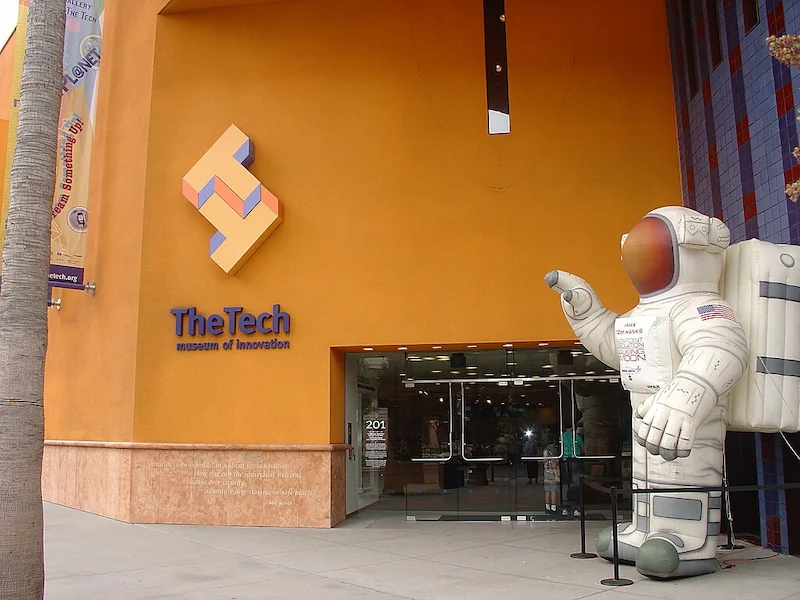Introduction
Last summer I visited The Tech Interactive, an innovation-focused technology museum for children in the heart of Silicon Valley. The museum—formerly called “The Tech Museum of Innovation”—provides an uncritical celebration of technological innovation. The museum is part of a larger social trend to aggrandize innovation.
The term “innovation” has come to connote problem-solving and technological progress. However, it is important to ask what the term hides. Who and what gets erased when we celebrate innovation? Who does the celebration of innovation benefit? In this essay, I draw on my research to explore answers to these questions, using The Tech Interactive as an example.
Climate Change and the Benevolence of Innovation
One of the things that struck me when I visited The Tech Interactive is that it treats an array of different social, political, and economic problems as merely technical problems. For example, the museum has an extended display, called “Solve for Earth,” on sustainability and climate change.
The name of the exhibit comes from the command to “solve for x” in a mathematical equation, suggesting that we just need to apply the right kind of logic and order of operations to solve climate change.
This framing removes climate change from its social, political, and economic context—implying that nothing needs to change in the broader world. To solve the earth’s problems, all we need is the right technology.
In a section of the exhibit with videos on “Emerging Technologies,” a placard declares that:
Solve for Earth celebrates innovators who are exploring the promise of technology to create a more sustainable future. . .. They are motivated by a desire to make the world better and healthier. These videos show that anyone can be an innovator.
The lesson here, and elsewhere in the museum, is that innovators are motivated by benevolence. Innovators innovate for the greater good, in order to solve humanity’s problems. Children are taught to emulate innovators, not to consider whether there might be reasons to critique certain innovations. The museum as a whole includes only passing references to the idea that technologies might raise ethical quandaries.
Artificial Intelligence: An Innovative Fix
As another example, let’s look at how The Tech Interactive frames “artificial intelligence.” AI appears in an exhibit on innovations in health care. In that exhibit visitors find different panel displays, each of which proffers a technological solution to a particular health care “need.”
In the AI segment, visitors are told “the need” that AI will solve is:
Big data, the existence of complex diseases, and a shortage of human brain power are challenges facing health care. Doctors can have an encyclopedic knowledge of human health, but they are not machines and can’t be everywhere at once.
Notice that the exhibit frames the problem in such a way that the innovation of AI is set up as the obvious solution. At The Tech Interactive, the fact that doctors are humans, not machines, becomes a problem. Furthermore, the big problem besetting healthcare is not a shortage of doctors, nurses, or other healthcare professionals. The problem is a “shortage of human brain power.” Defining the problem in this way makes the solution obvious: computer “brain” power, driven by AI. As the exhibit proclaims, “AI can be the ultimate smart assistant for doctors.”
A different way to frame a key, related problem in health care is that there are not enough doctors and nurses, particularly in rural and other underserved communities. If the problem were defined in this way, then the solution would involve investing in healthcare infrastructure. Structural, political, and economic factors that impede access to quality healthcare would need to be addressed. The AI tech fix hides those structural issues. This uncritical celebration of innovation is hardly confined to this museum or to Silicon Valley.
The Depoliticization of Innovation
Policy makers, media, and corporate actors often present innovations as benevolent solutions. This framing reflects a broader function of the ideology of innovation. It trains the public to accept innovations as unequivocally good, and as things that are somehow above or outside politics. While technologies certainly have an important role to play in addressing climate change and many other social problems, the museum’s presentation of technology hides the fact that technology is deeply embroiled with politics.
If we understand politics as the terrain of struggle over values, the depoliticization of innovation places it as a value beyond question. When technological innovation is viewed as the solution to all problems, every problem gets defined as a technical problem. This erases the fact that entrenched problems are political problems.
For example, the tech fix framing obscures the political and economic roots of the climate crisis, wrongly suggesting that the crisis can be solved merely with the right technology. This view can even make the crisis worse as it draws attention and resources away from addressing systemic causes. The ideology of innovation justifies funneling resources to technology companies that claim their next innovation will solve an important problem.
Erasing Reproductive Labor
There is something else that is erased when innovation is overvalued. In my research, I argue that as innovation has become overvalued, reproductive labor has become further devalued. Reproductive labor is the crucial work of caring for and sustaining communities. It is labor that tends to be done by women, and disproportionately immigrant women and women of color. It involves things like caring for children, the sick, and the elderly.
State and corporate actors tend to treat innovation as a concern of the public sphere. As such, innovation should be encouraged through deregulation and public resources because innovations provide a collective good. In contrast, the dominant public view of reproductive labor in the United States has been that it is a domestic and private matter. Consequently, it should not be publicly supported.
These two phenomena are related. The overvaluation of innovation has the effect of obscuring the importance of reproductive labor, hence further devaluing it. Whereas innovation connotes progress and masculinity, reproductive labor is associated with tradition and femininity. As feminists have long argued, reproductive labor is the foundation of society and the economy. Yet, it is often devalued and poorly remunerated. The view that innovation is the true driver of social wellbeing hides the social value of reproduction.
Consider, again, The Tech Interactive’s touting of AI as the solution to a healthcare need. The framing of this problem ignores the important role that care workers like home health aides and nurses do to support people with health issues. From another perspective, one of the key problems of the healthcare system in the US is that there is anemic public support for these essential reproductive laborers and the people for whom they care. This example shows how the aggrandizement of technological solutions hides the importance of the more mundane, but absolutely essential work of reproductive labor.
Hiding Corporate Wealth Accumulation
Who benefits from framing innovation as unequivocally good and as a solution to myriad problems? There are hints scattered throughout The Tech Interactive. The exhibits are dotted with small placards that acknowledge the various funders of the exhibits, including Lockheed Martin, healthcare technology company Abbott Laboratories, Nvidia, and the Ford Motor Company.
As I left the museum, I walked through the “new venture hall.” There I found a placard declaring the hall “a tribute to venture capitalists and investment bankers who play a crucial role in creating and building Silicon Valley and who support The Tech in its mission to inspire the innovator in everyone.”
Explore Books Written by Our Contributors
As these funders understand, the narrative that we see in The Tech Interactive has material consequences. It helps to justify the many policy shifts in the US that aim to prop up “innovators.” This often means using public money to subsidize private wealth accumulation. Corporations and investors have benefited handsomely from policies, including deregulation and tax cuts, enacted in the name of incentivizing innovation. The societal preoccupation with innovation in fact contributes to a key political problem: the outsized wealth and influence of private investors and corporations that is undermining democracy.
At the same time, material support for reproduction and for those who require care have been gutted even more. This has been happening in the US over the last several decades, with the current administration further decimating social welfare programs. Increased investor and corporate wealth goes hand-in-hand with cutting social support in the name of austerity.
Conclusion
It may seem odd to critique an emphasis on the greater good in children’s education. However, part of what makes innovation ideology so effective is the way that innovation has been symbolically harnessed to the common good. The Tech Interactive presents science and technology as imbued with universal, uncontested values of benevolence and the common good. Innovation signifies prosperity and progress. This helps to hide the downsides of our societal obsession with innovation.
One of those downsides is the devaluation of reproductive labor. It is thus crucial to understand how the rise of innovation is intertwined with the devaluation of reproductive labor. Unraveling this connection is necessary in order to make our way toward a world that better values reproductive labor and the people who perform that work. We must understand reproductive labor as a key contributor to the common good, and as foundational to our communities.










